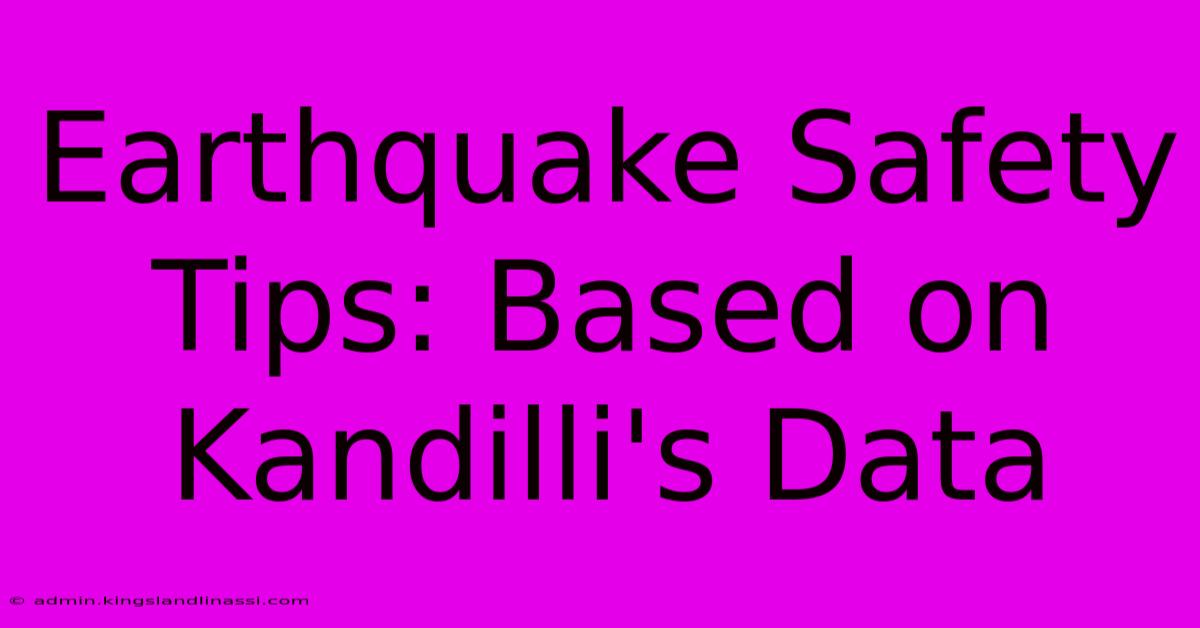Earthquake Safety Tips: Based On Kandilli's Data

Table of Contents
Earthquake Safety Tips: Based on Kandilli's Data
Earthquakes are a stark reality for many, particularly those living in seismically active regions. Understanding earthquake safety is crucial, and leveraging data from reputable sources like Kandilli Observatory and Earthquake Research Institute (KOERI) – a leading seismological institution – can significantly improve preparedness. This article will explore practical earthquake safety tips informed by Kandilli's data and expertise, helping you protect yourself and your loved ones.
Understanding Earthquake Risks Based on Kandilli's Data
Kandilli Observatory provides invaluable data on earthquake frequency, magnitude, and location in Turkey and surrounding regions. Analyzing this data reveals several key insights for enhancing safety:
-
Frequency and Magnitude: Kandilli's data illustrates the frequency and magnitude of earthquakes in your specific area. This allows for a more accurate assessment of personal risk. Understanding that your region experiences frequent, smaller tremors versus infrequent, high-magnitude events will shape your preparedness strategy.
-
Seismic Zones: Kandilli's data helps define high-risk seismic zones. Knowing your location's seismic classification informs the level of preparedness necessary. Areas identified as high-risk require more stringent safety measures than those in lower-risk zones.
-
Predictive Modeling (with limitations): While precise earthquake prediction remains elusive, Kandilli's research contributes to predictive modeling, offering probabilistic assessments of future earthquake likelihood. This information isn't a crystal ball, but it helps communities allocate resources effectively.
Before the Earthquake: Proactive Safety Measures
Informed by Kandilli's data on earthquake frequency and intensity, proactive measures are key:
Develop an Emergency Plan:
-
Identify Safe Spots: Designate safe places within your home, such as under sturdy tables or in doorways (avoiding glass or heavy objects). Kandilli's data on typical earthquake shaking intensity in your area can help you choose the most appropriate locations.
-
Emergency Kit: Prepare an emergency kit containing essential supplies: water, non-perishable food, first-aid kit, flashlight, radio, extra batteries, important documents (copies), and medications.
-
Communication Plan: Establish a communication plan with family and friends, including designated meeting points and contact numbers. Cell service may be disrupted after an earthquake.
-
Secure Heavy Objects: Secure heavy furniture and appliances to walls to prevent them from falling during shaking. This reduces potential injury and damage, particularly vital in high-risk areas as indicated by Kandilli's data.
Strengthen Your Home:
- Structural Assessment: Consider a professional structural assessment of your home, especially if it's located in a high-risk seismic zone. Reinforcements suggested based on Kandilli's findings can significantly improve your home's earthquake resistance.
During the Earthquake: Immediate Actions
When an earthquake strikes, swift action is crucial. Remember these steps:
-
Drop, Cover, and Hold On: This simple technique is highly effective. Drop to the ground, take cover under a sturdy table or desk, and hold on until the shaking stops. This minimizes your risk of injury from falling debris, a key concern highlighted by Kandilli's earthquake impact studies.
-
Stay Away from Windows and Exterior Walls: These areas are prone to damage during shaking.
-
If Outdoors, Find an Open Area: Move away from buildings, power lines, and other hazards.
After the Earthquake: Post-Shake Safety
Post-earthquake safety is equally critical:
-
Check for Injuries: Assess yourself and others for injuries. Provide first aid as needed.
-
Check for Damage: Carefully inspect your home for structural damage. If you suspect significant damage, evacuate immediately.
-
Follow Official Instructions: Listen to official announcements from emergency services for further instructions.
-
Conserve Resources: Conserve water, food, and other resources as supplies might be limited.
Conclusion: Preparedness is Key
Kandilli Observatory's data provides crucial insights into earthquake risks, enabling individuals and communities to enhance their safety measures. By understanding your specific risk level and implementing these proactive and reactive safety tips, you can significantly improve your chances of surviving and recovering from an earthquake. Remember, preparedness is the best defense against the unpredictable power of nature.

Thank you for visiting our website wich cover about Earthquake Safety Tips: Based On Kandilli's Data. We hope the information provided has been useful to you. Feel free to contact us if you have any questions or need further assistance. See you next time and dont miss to bookmark.
Featured Posts
-
Normal Blood Pressure An Age Specific Look
Apr 21, 2025
-
Raising Resilient Toddlers Tips And Strategies
Apr 21, 2025
-
Carles Minarro Garcia Age The Mystery Unveiled
Apr 21, 2025
-
Emmy Rossums Daughter A Legacy In The Making
Apr 21, 2025
-
Ben Afflecks Net Worth The Power Of Diversification
Apr 21, 2025
